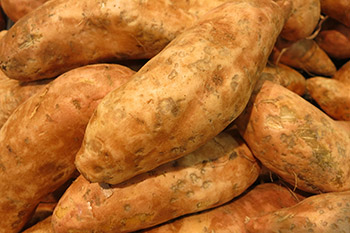
Description
- Sweet potato is a member of the Convolvulaceae family, more commonly known as the morning glory family.
- Worldwide more than 6,000 varieties of sweet potatoes exist. They come in various shapes and colors ranging from orange to red to white to purple.
- Much confusion exists between sweet potatoes and yams. Yams are a completely distinctive plant in a different botanical family. Sweet potatoes are commonly labeled as yams in the grocery store, but yams are a starchy root vegetable with an entirely different nutrient profile. Their appearance is generally rough and scaly on the outside and they can grow to be over four feet in length. So the “yam” in your local grocery store is likely a sweet potato.
Health Benefits
- A one cup serving of sweet potatoes is an excellent source of vitamins A, C, and B6, potassium, and fiber.
- Vitamin A encourages healthy vision, skin, reproduction, and immune function.
- Vitamin C increases absorption of iron, plays a part in wound healing and helps to repair and maintain bones, teeth, and cartilage.
- Vitamin B6, otherwise known as pyridoxine, is required for protein metabolism, brain development during pregnancy and infancy, and plays a role in immune function.
- Potassium assists in blood pressure control and supports the communication of nerves and muscles.
- Fiber supports a healthy digestive system by preventing constipation. Fiber also promotes a feeling of fullness which can contribute to weight control due to reducing the amount of food you eat.
- Sweet potato is an excellent source of beta carotene which is converted into vitamin A in the body. Beta carotene is an antioxidant which protects the body from free radicals which damage cells and promote disease.
Selecting, Storing, and Preparing
- Sweet potatoes are available year round at grocery stores. Most sweet potatoes in the U.S. are grown in the South due to the warmer climate and longer growing season. As of 2014, North Carolina has been the number one sweet potato producer in the U.S. since 1971.
- Select firm sweet potatoes with smooth skin. Avoid those with soft spots, cracks or blemishes.
- Store sweet potatoes in a cool dry area.
- Prepare sweet potatoes by boiling, baking, steaming, microwaving, or grilling. They can also be dehydrated to make delicious chips. Just wash the outside of the sweet potato prior to using. If baking or microwaving, poke holes into the sweet potato to allow steam to escape.
- Slice, dice or cut into wedges or matchsticks.
Nutrition Facts
1/2 cup cooked
Calories: 15 | Protein: 1.24 g | Fat: 0.16 g | Carbohydrate: 2.92 g | Fiber: 1.1 g | Calcium: 21 mg | Magnesium: 9 mg | Potassium: 139 mg | Vitamin C: 39.2 mg | Folate: 28 μg | Vitamin A: 274 IU
ndb.nal.usda.gov
Request an Appointment

